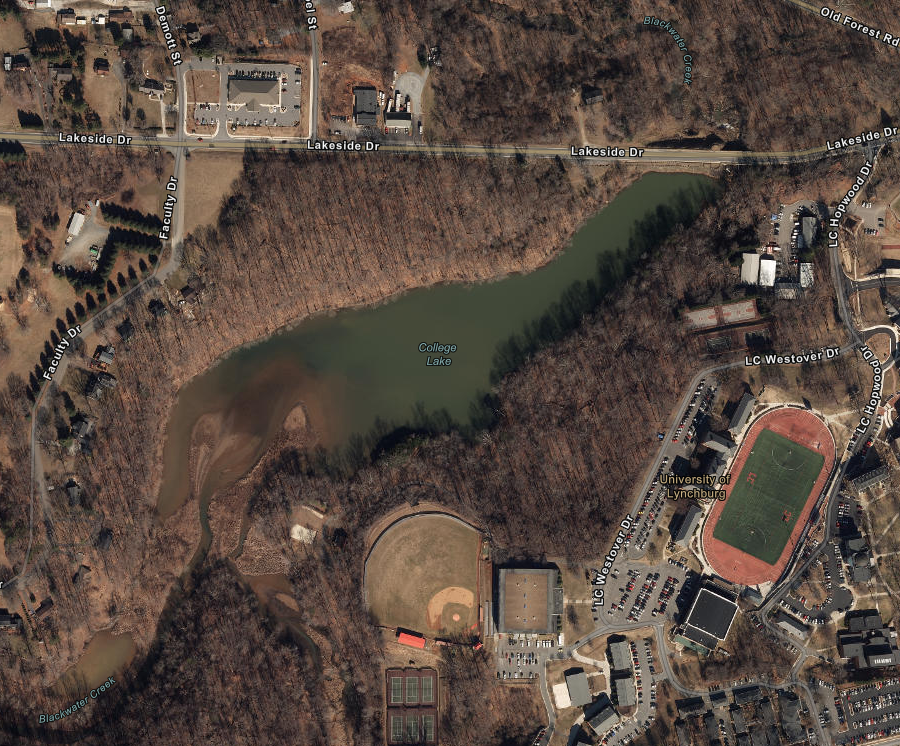
College Lake was created in 1934 by a dam across Blackwater Creek next to Lynchburg College (now University of Lynchburg)
Source: ESRI, ArcGIS Online

College Lake was created in 1934 by a dam across Blackwater Creek next to Lynchburg College (now University of Lynchburg)
Source: ESRI, ArcGIS Online
A dam was built across Blackwater Creek next to Lynchburg College in 1934, creating a 44-acre lake that was 30' deep in places. The college wanted a lake, and provided land for the Virginia Department of Highways to build a dam 300' long rather than a bridge when constructing the new highway (now US 221, Lakeside Drive) across the creek. A three-foot high rock wall was built across the spillway in 1935 to raise the lake level, but later enough was removed to restore the lake to its original level.
At least once, the lake was stocked with fish. A State Game and Fish Commission truck carrying fingerlings for release in other stream had a mechanical failure when near College Lake. Rather than let the fish die from heat and oxygen deprivation in the truck, the fingerlings were released into College Lake.
Since construction, sediments eroding from Blackwater Creek's 42,000 acre watershed have accumulated behind the dam. College Lake shrank in size from 45 acres in the 1930's to 14 acres by 2020, with an average depth of just seven feet. Between 1971 and 2002, the average depth of the lake was reduced by three feet. Upstream erosion triggered particularly by commercial development in the watershed brought more sediment down Blackwater Creek. When the speed of the water slowed at the dam, suspended and dissolved sediment settled out and reduced the size of College Lake.
When Lynchburg College adopted the new "University of Lynchburg" name on July 1, 2018, the lake's name was left unmodified. The need to change the condition of the lake was described by the University of Lynchburg:1
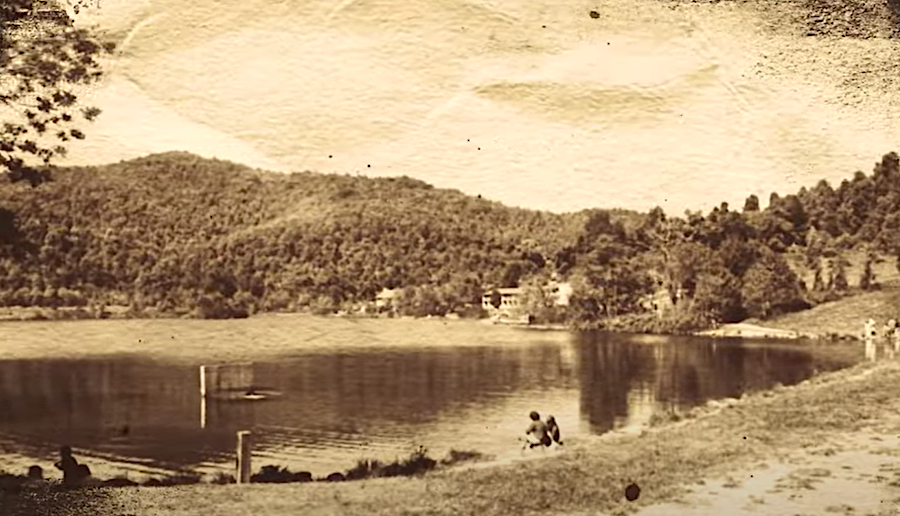
sediment filled College Lake, reducing it in size from 45 acres to 14 acres
Source: Lynchburg Water Resources, College Lake Dam Removal: Remove. Restore. Reconnect.
The capacity of the spillway was inadequate to handle anticipated flooding. The 35' high dam with an impervious clay center was classified as "high hazard," based on Virginia's dam safety regulations that were updated in 2008. The 60' wide spillway built in 1934 lacked the capacity to discharge the amount of water which could flow down Blackwater Creek in a storm and accumulate behind the dam, creating the risk of catastrophic failure. A new spillway would have to be wider/deeper enough to handle over 10 times the current capacity, in order to met current dam safety standards.
Since 2011, the state has not issued an operation and maintenance certificate for the dam. Instead, College Lake Dam was placed in "conditional" status because of is risk of failure in a major storm. In 2014 the City of Lynchburg began to assess options for meeting the dam safety standards. Reinforcing the dam so floodwaters could flow over the top without eroding the clay core was predicted to cost $8.5 millon. Removing the dam and restoring the lakebed was predicted to cost nearly $10 million.
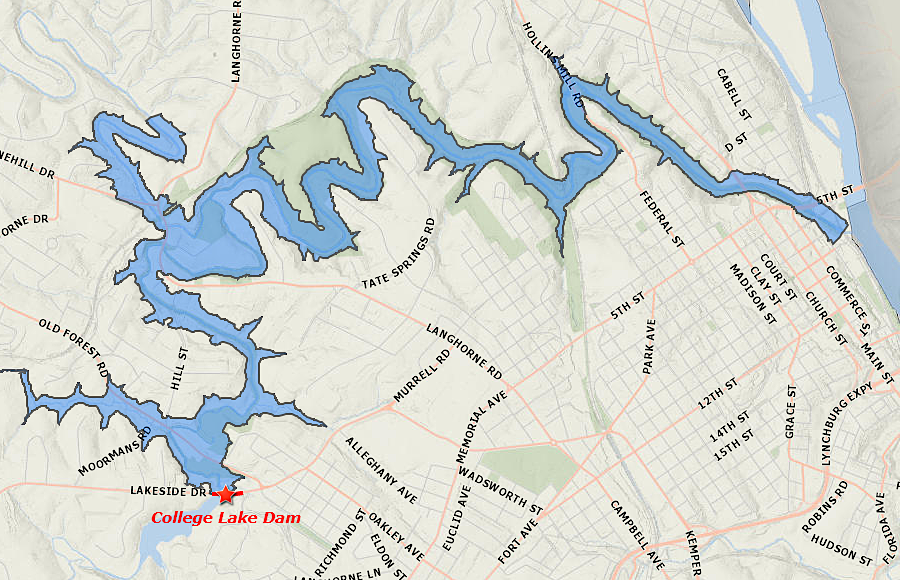
area of Maximum Probable Flood after a break of the College Lake dam
Source: City of Lynchburg, College Lake - Dam Inundation
There were two major choices: rehabilitate the dam and retain College Lake, or remove the dam and create a wetland. The city owned the road and dam, but it coordinated closely with the University of Lynchburg because it owned the bed of College Lake. College students had been studying the environmental conditions of the lake for nearly 50 years, and it was a convenient outdoor laboratory on the campus. A University of Lynchburg environmental science professor commented:2
As the studies were underway, heavy rains caused Blackwater Creek to flood on August 2, 2018. College Lake rose above Lakeside Drive and water began to erode the downstream side of the 35' high embankment. The city declared an emergency and evacuated 150 people from downstream of the dam, opening a shelter at E.C. Glass High School.3
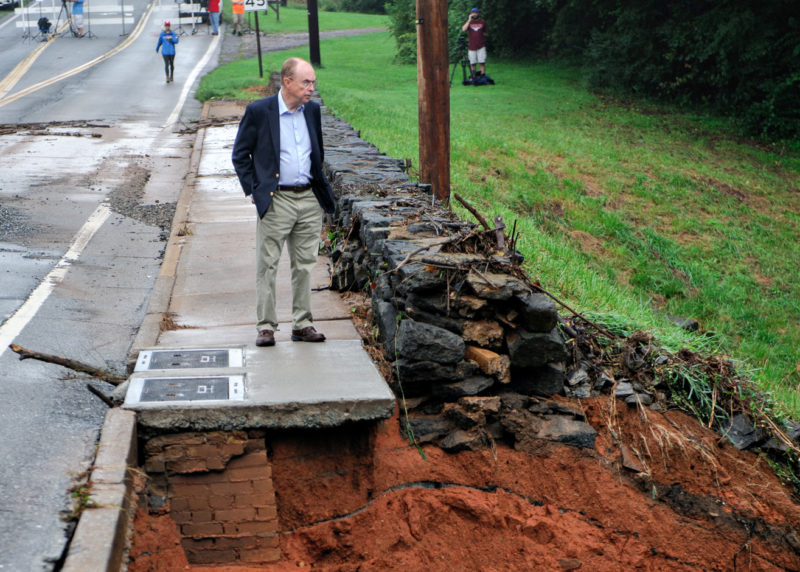
the president of the University of Lynchburg, viewing damage to the embankment after College Lake overflowed
Source: University of Lynchburg, College Lake through the years
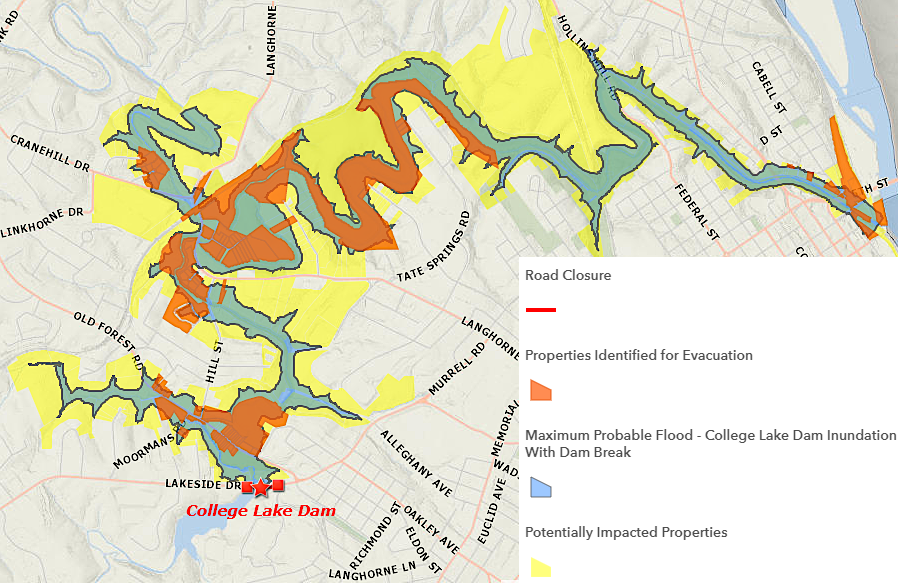
area below Lakeside Drive that would be affected by flooding if water flowed over the College Lake dam
Source: City of Lynchburg, College Lake - Dam Inundation
College Lake was drained while emergency repairs to the dam were implemented. A helicopter spread seeds of wetland plants over the exposed muddy sediments, to stabilize the lakebed and minimize sediments washing downstream.
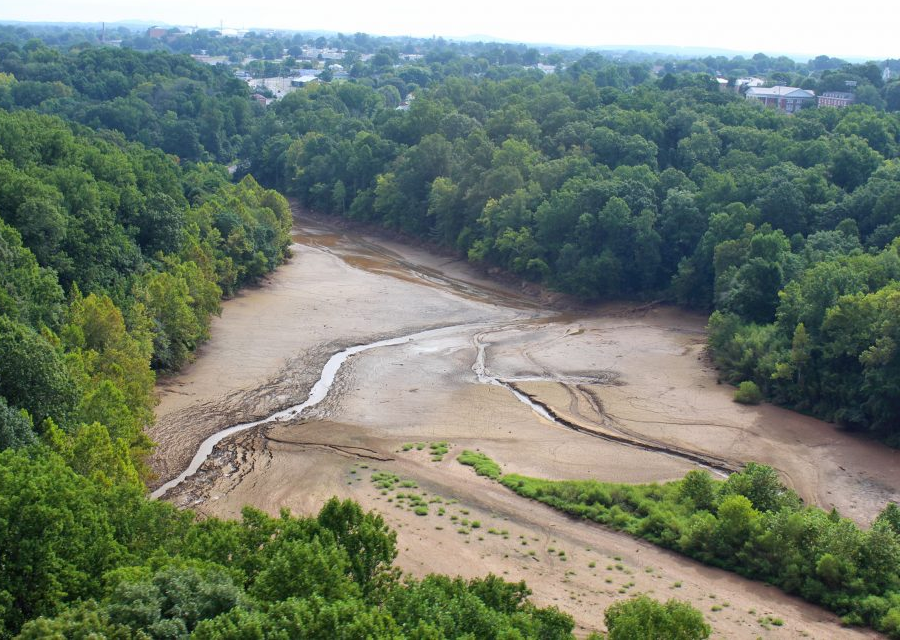
College Lake was drained days after the flood on August 2, 2018
Source: University of Lynchburg, College Lake site to become wetland learning laboratory
Long-term costs to restore the lake and the dam were estimated initially around $20 million. Within three weeks after the flood, the City of Lynchburg and the University of Lynchburg adopted a joint long-term vision to replace College Lake:4
University of Lynchburg President Dr. Kenneth R. Garren said:5
The decision not to refill College Lake was changed two months later. Without the slackwater at the lake, Blackwater Creeks was carrying sediment directly to the James River and debris was clogging the spillway. An engineering study revealed that keeping the lake empty lake would not reduce the risk of another flood. A spokesperson for Lynchburg Water Resources said:6
As a temporary measure, College Lake was refilled in October, 2019, with plans to drain it permanently only after the City of Lynchburg built a four-lane bridge over Blackwater Creek, while retaining the old bridge over the spillway. The new Lakeside Drive bridge was expected to cost $28.5 million.
Sediment management and lakebed restoration would cost an additional $20 million. In the 2019 session of the General Assembly, Lynchburg's representatives succeeded in getting a $5 million state matching grant included in the budget.
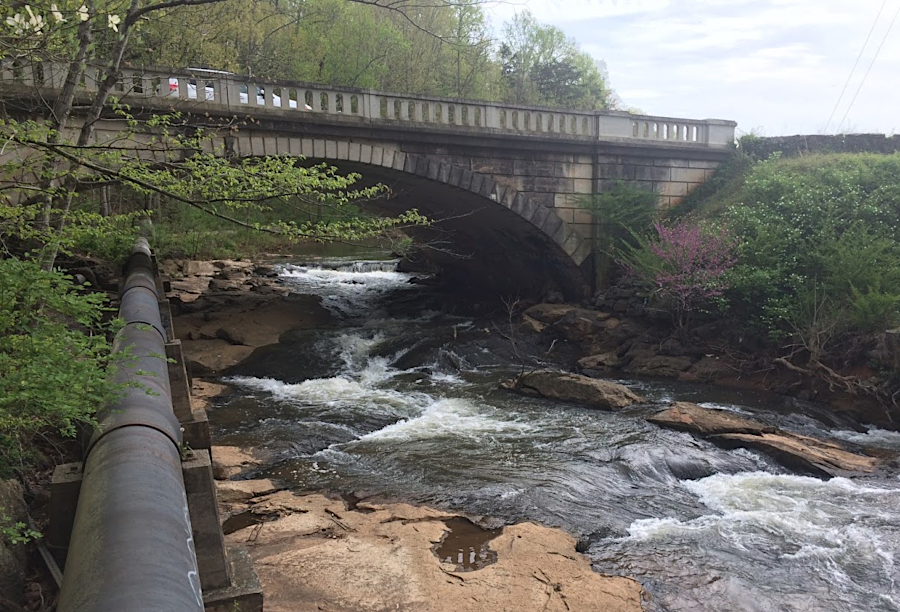
replacing the College Lake dam required building a new US 221 (Lakeside Drive) bridge over Blackwater Creek
When City Council approved the first $10 million for those costs, once member noted that the College Lake costs would delay other previously-planned projects in the Capital Improvement Plan - but he voted in favor, because the dam replacement was such an obvious priority. A 25-year storm event could lead to water overtopping the dam, so there was a 4% chance every year of a major disaster until the dam was removed.
One short-term option was to lower the spillway by 5-10 feet, reducing the lake level and lowering the risk of a dam breach. Lowering the spillway would cause massive amounts of silt to wash downstream, creating environmental damage to fish and wildlife in Blackwater Creek and the James River. A study determined that even with a lower lake level, the risk of a dam failure remained too high.7
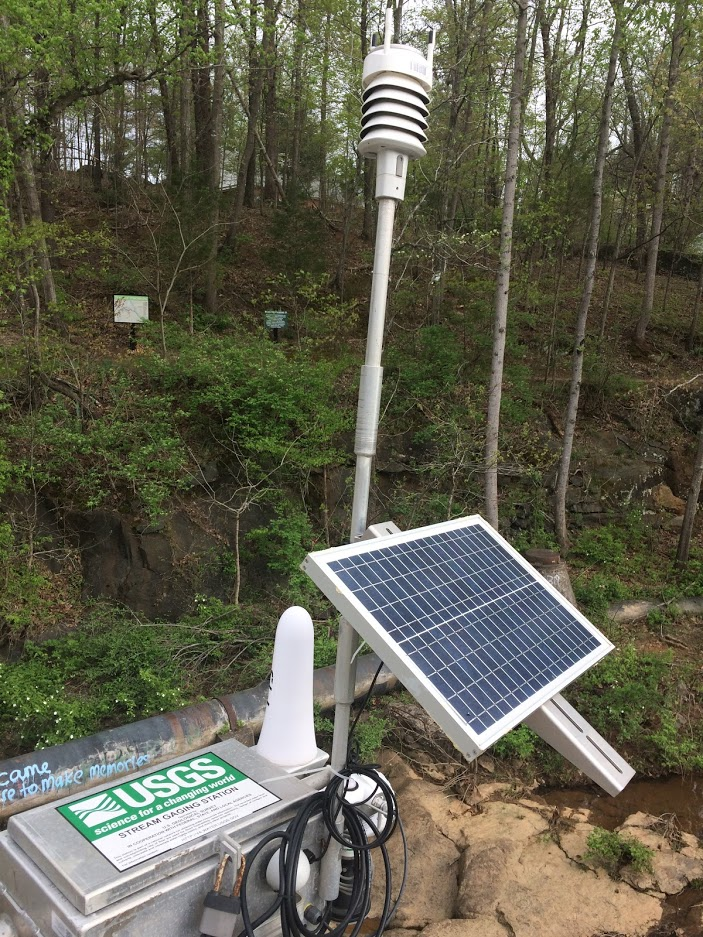
the USGS gauge at College Lake, on US 221 (Lakeside Drive) bridge in Lynchburg, allows a faster response in a future rainstorm
The construction of the new bridge and conversion of College Lake into a riverine ecosystem and wetland started in 2020. Completion was anticipated in 2025. First a new bridge for Lakeside Drive was built downstream of the 1934 dam, so traffic could cross Blackwater Creek. Moving Lakeside Drive was a $26 million project. Removing the dam and managing the silt which had accumulated since 1934 in the bed of College Lake cost an additional $17.5 million.
Sediment control included moving 130,000 cubic yards of silt to reestablish the stream channel through the lakebed. Lynchburg officials made a judgment call that dam removal was needed for safety, but there was an environmental risk that storms over the next 25 years would transport 90 years of legacy sediments downstream to the Chesapeake Bay.
College Lake had served as a stormwater pond stopping sediment from moving downstream into the James River for 90 years. After dam removal, it would no longer capture silt. Environmental protection depended instead upon stronger erosion and sediment controls that limited stormwater transport of silt when land was cleared for new development upstream.
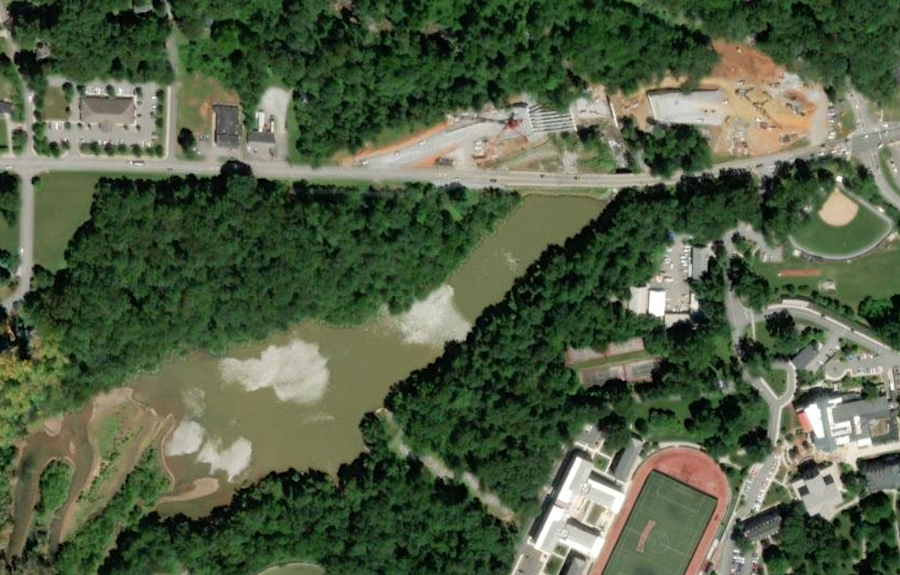
a new bridge for Lakeside Drive was constructed across Blackwater Creek and opened in 2022, before the dam was removed in 2024
Source: ESRI, ArcGIS Online
Dewatering the lake was planned via pumps and siphons, with pipes placed on top of the dam. Lowering the water level 6-12" per day, rather than breaching the dam, avoided sending a surge of sediment downstream.
The contract to remove the dam was awarded at the end of 2023. The president of the University of Lynchburg said:8
Source: Lynchburg Water Resources, College Lake Dam Removal: Remove. Restore. Reconnect.
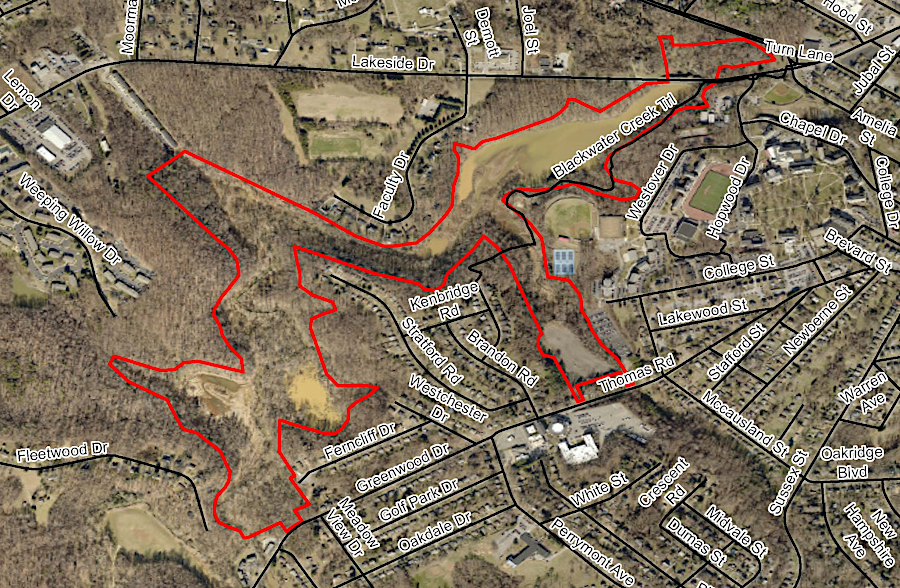
area affected by the conversion of College Lake to a wetland
Source: City of Lynchburg, City and University of Lynchburg Announce Phase One of College Lake Dam Removal Project
A new $27 million Lakeside Drive Bridge opened in 2022 to handle the traffic, about 17,000 vehicles a day. The dam was removed on May 20-24, 2024. Water could flow unhindered downstream to the James River, but the dam no longer trapped sediment and pollution in College Lake. A new channel of the creekbed was excavated to include curves designed to slow water flow and minimize future erosion, while the former lakebed evolved into wetland habitat.
A portion of the old Lakeside Drive bridge was kept intact to serve as an overlook of Blackwater Creek's stream valley as a new forest grows.9
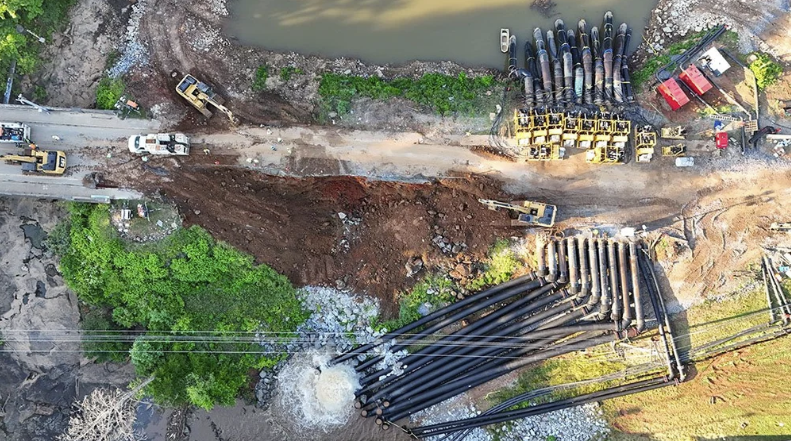
College Lake was pumped dry and the dam removed in May, 2024
Source: Lynchburg Water Resources, College Lake Dam Removal - News
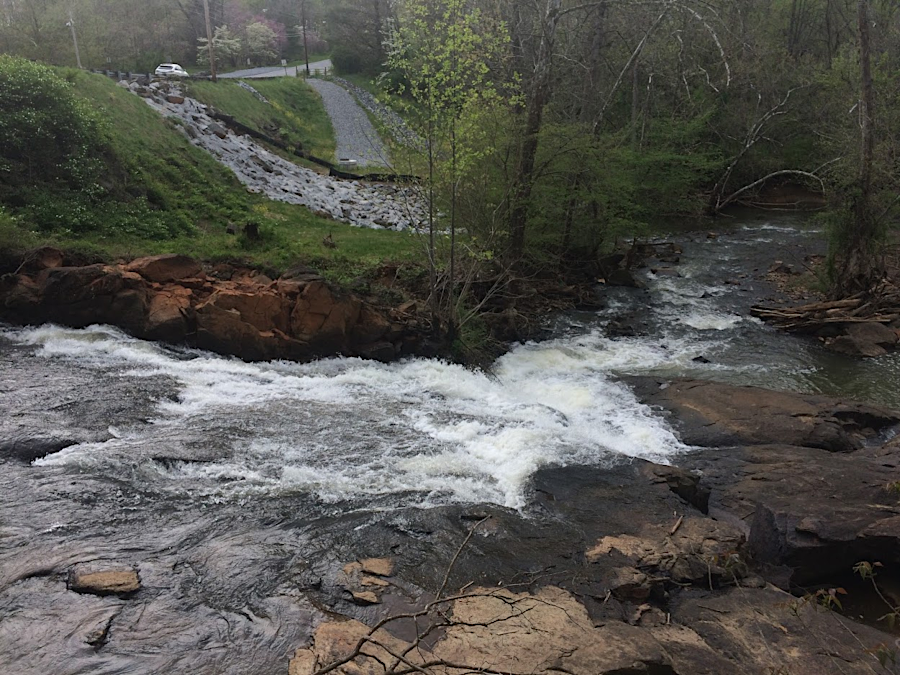
Blackwater Creek downstream of College Lake and US 221 (Lakeside Drive), as seen from the spillway bridge in April, 2019
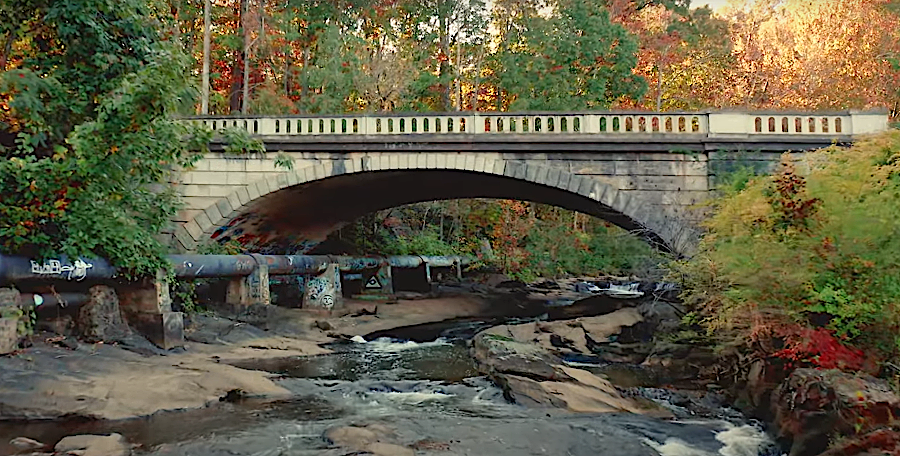
the 1934 bridge over the spillway was retained as an overlook, rather than removed with the dam
Source: Lynchburg Water Resources, College Lake Dam Removal: Remove. Restore. Reconnect.
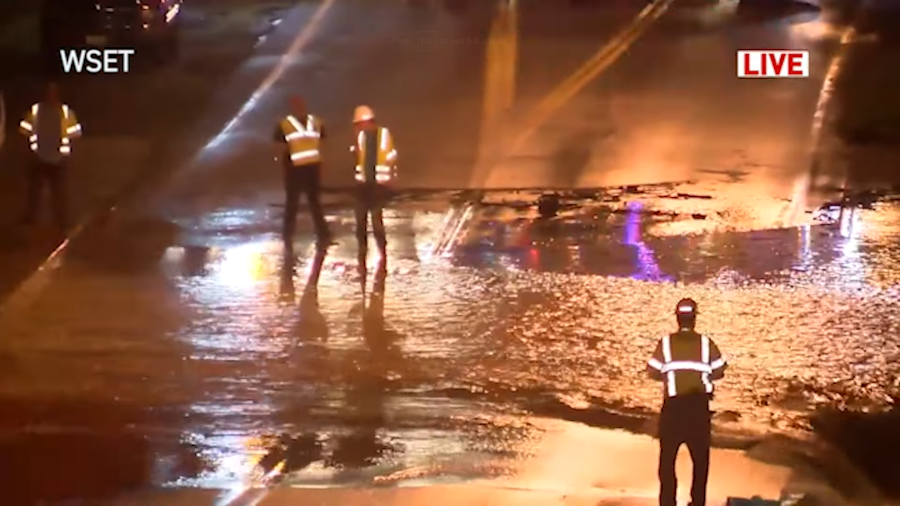
water flowed over the top of College Lake Dam in the 2018 flood
Source: Lynchburg Water Resources, College Lake Dam Removal: Remove. Restore. Reconnect.
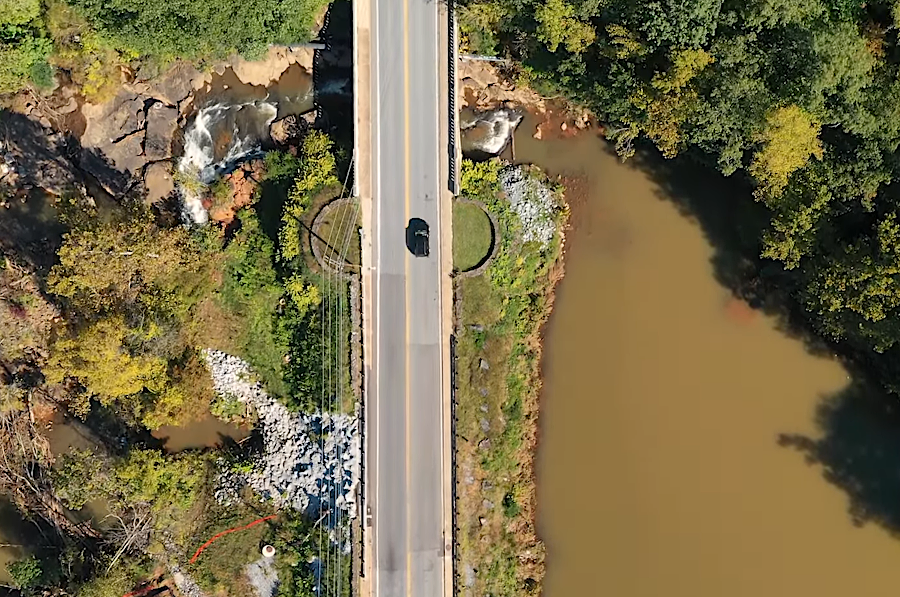
College Lake Dam was temporarily reinforced after the 2018 flood
Source: Lynchburg Water Resources, College Lake Dam Removal: Remove. Restore. Reconnect.
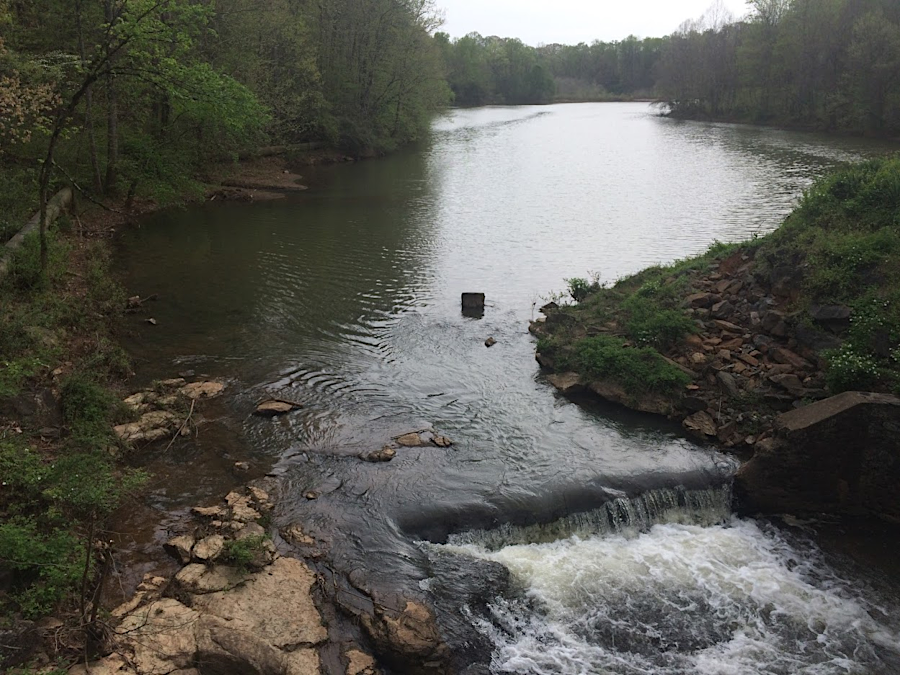
College Lake in April, 2019
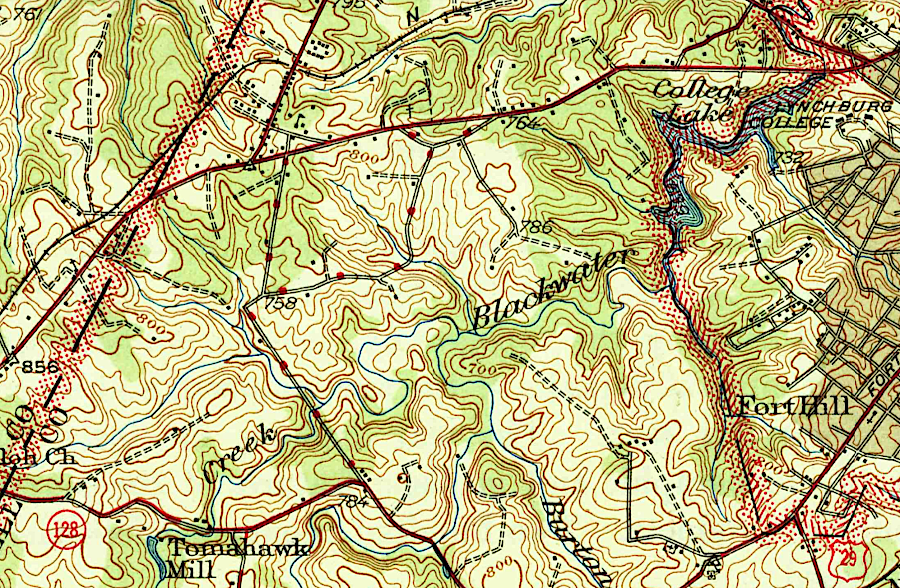
in 1944, upstream of College Lake was farmland and forest
Source: US Geological Survey (USGS), Lynchburg 1:62,500 topographic quadrangle (1944)
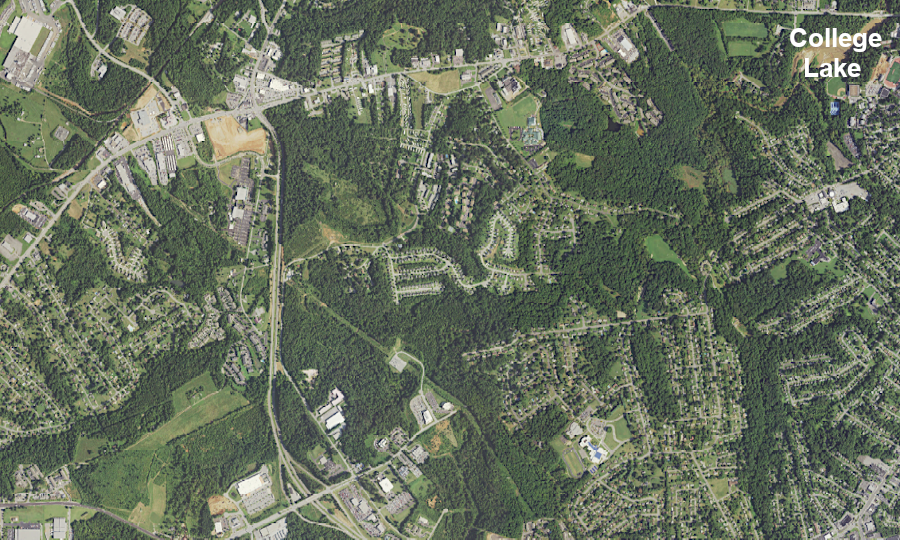
by 2022, erosion from development upstream of College Lake had increased substantially
Source: US Geological Survey (USGS), Lynchburg 1:24,000 topographic quadrangle (2022)